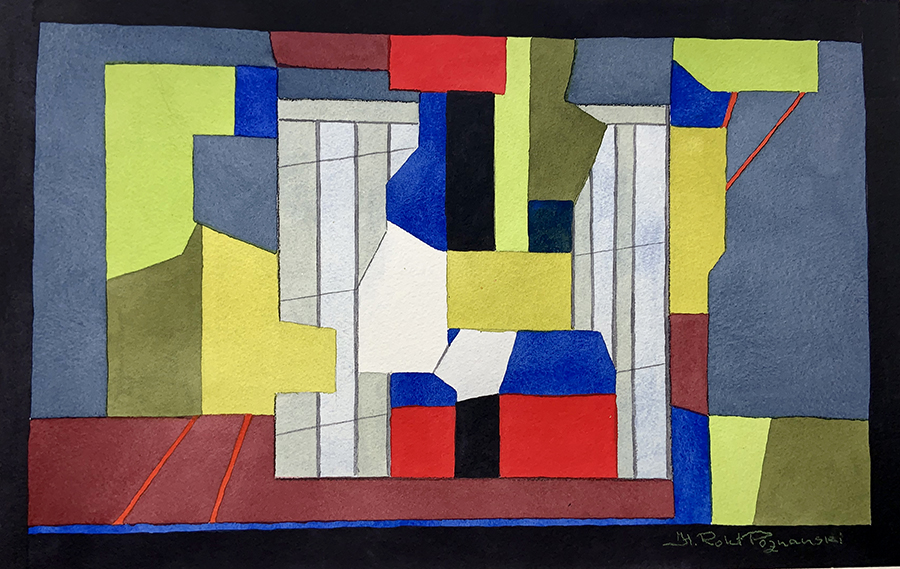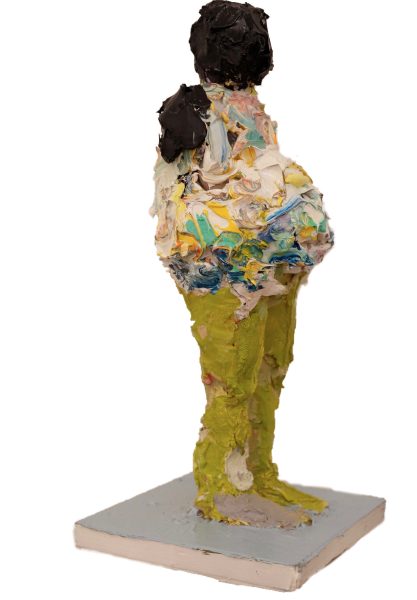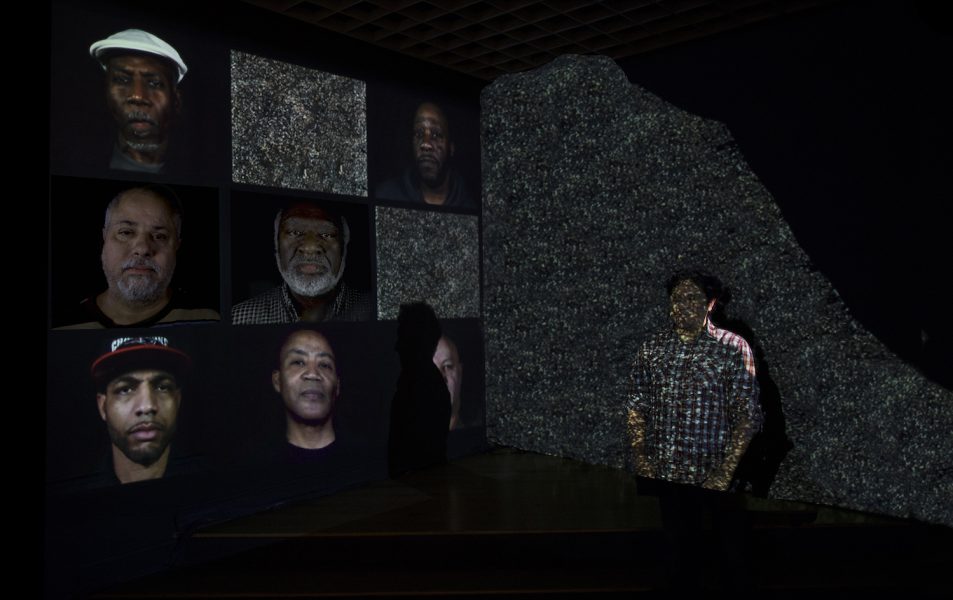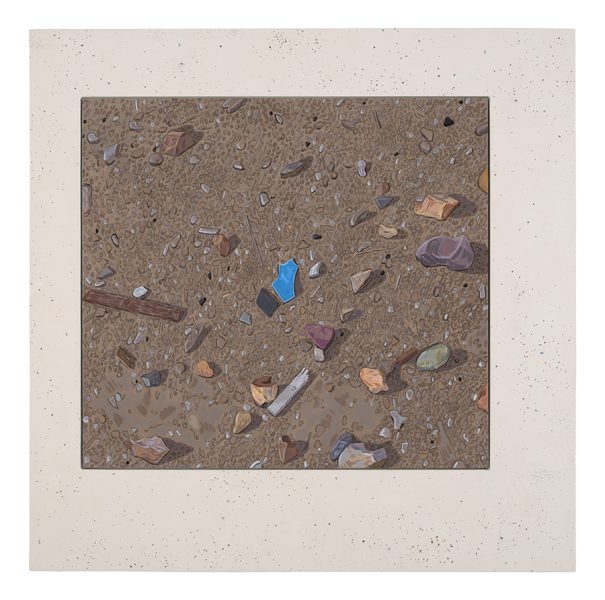(Boston, MA—July 18, 2019) The Institute of Contemporary Art/Boston (ICA) presents the 2019 James and Audrey Foster Prize exhibition with major works on view from Boston-area artists Rashin Fahandej, Josephine Halvorson, Lavaughan Jenkins, and Helga Roht Poznanski. This intergenerational group of artists works across media, including painting, sculpture, and video, to explore questions of place, portraiture, and belonging. On view from August 21 to December 31, 2019, the exhibition is organized by Ruth Erickson, Mannion Family Curator.
“We are ever grateful to Jim and Audrey Foster for their inspired support of the ICA. The James and Audrey Foster Prize exhibition highlights the strength, dynamism, and depth of Boston’s arts community. We are eager to share with the public a broad range of talent in this important biennial showcase,” said Jill Medvedow, Ellen Matilda Poss Director.
“The 2019 Foster Prize artists exemplify the dynamic breadth of work being created in Boston’s artistic community,” said James Foster, ICA Trustee, and Audrey Foster, ICA Advisory Board Member.
The James and Audrey Foster Prize is key to the ICA’s efforts to nurture and recognize exceptional Boston-area artists. First established in 1999, the Foster Prize (formerly the ICA Artist Prize) expanded its format when the museum opened its new facility in 2006. James and Audrey Foster, passionate collectors and supporters of contemporary art, endowed the prize, ensuring the ICA’s ability to sustain and grow the program for years to come.
Each iteration of the James and Audrey Foster Prize Exhibition highlights a new area of focus within Boston’s rich ecology of contemporary art practices. To select the 2019 Foster Prize artists, Erickson conducted studio visits with 50 artists living and working in the Boston-area over the past year. Relying upon ongoing recommendations from curators, artists, and other colleagues, she previewed more than 150 artists’ work online, and set up studio visits with 50 of these artists. Intent to view a broad cross-section of artists, Erickson assured she met with practitioners working in all media and with varied backgrounds and training.
“This exhibition presents a sliver of the countless talented artists who have trained at and teach in Boston’s numerous art schools,” said Erickson. “I am humbled by the generosity of these artists and grateful to Jim and Audrey Foster for the opportunity to share their work with ICA audiences.”
The exhibition begins with a selection of tightly-composed, abstract watercolors by Helga Roht Poznanski that reflect her training in fashion and fine art, as well as her own life experience fleeing her native Estonia and immigrating to Vienna, and then to Canada and the United States. Poznanski begins these works first as collages, tearing colored and patterned paper from fashion magazines. These collages serve as studies for her final watercolors, which she paints using a dry watercolor technique to achieve bold colors and crisp lines. Her paintings possess a complex pictorial space, with nested and overlapping forms, windows and portals, moons and suns, evoking fractured views of a cityscape.
The next gallery presents forty three-dimensional, figurative “paintings” by Lavaughan Jenkins on individual shelves lining the walls. Building the human figure through the layering of oil paint over an armature of wire, molding paste, and Styrofoam, Jenkins describes his tabletop sculptures as “paintings,” and he is centrally invested in the effects of form, color, and light. The sculptures include figures vaguely resembling the artist—with black skin and a full girth—to regal figures in full skirts that Jenkins refers to as “duchesses.” Some figures are sitting or kneeling, others are standing; many lack arms or other features that fully define the human form; and often they appear to interact in small groupings. Such modifications lend the sculptures an incredible range of emotions, especially as each one seems to express particular emotional or psychological states in relationship to power. The kneeling and armless figures that read as men especially evoke a sense of humility, shame, or even emasculation. Jenkins derives his color palettes from his study of high fashion, especially the collections of designers like Valentino. His unique hand combines a roughness of form and paint application with the delicacy of oil built up.
An immersive and interactive installation of Rashin Fahandej’s multipart and ongoing project A Father’s Lullaby fills the next gallery. Initiated in response to the absence of fathers in communities of color as a direct result of mass incarceration, this project harnesses song, storytelling, and video to convey the love and loss as a result of incarcerated fathers. A multi-channel video and sound piece presents the images and sounds of community members and formerly incarcerated men who hum lullabies they remember from their childhood or sang to their own children. Interactive touch panels activate the playing of individual stories, and mirrors throughout the space reflect the projected images and the bodies of visitors, merging these two and considering the shared space of their interaction and empathy.
The final gallery is the exhibition is dedicated to the work of Josephine Halvorson, whose painting practice focuses on place and the careful acts of observation and transcription. Working in gouache on paper mounted to canvas, Halvorson selects a particular place, sets up her tools and materials, and takes in her surroundings, easel, and looks at the ground, translating what she sees into painted marks. The resulting paintings capture the heterogeneity and brilliance of the mundane, revealing each square inch to hold countless marks, colors, and shapes. This exhibition presents recent gouache paintings made at two different locations: five paintings made at an abandoned mine in Death Valley, California, and two large panoramic works made in Western Massachusetts. In these works, Halvorson has further experimented with making a visceral connection to site through not only representation and observation but also material. Collecting stones, soil, and debris from the sites where she paints, she grinds these materials and mixes them with pigment to create subtly distinct “frames” for her gouache paintings.
The Artist’s Voice
Thu, Sep 26, 7 PM
Rashin Fahandej, Josephine Halvorson, Lavaughan Jenkins, and Helga Roht Poznanski will discuss their processes, and works, and participation in the Foster Prize exhibition in a public talk moderated by Mannion Family Curator Ruth Erickson.
About the artists
Rashin Fahandej (b. 1978, Shiraz, Iran) is an Iranian-American artist and independent filmmaker. Her work centers on marginalized voices, and the role of media, technology, and public collaboration in generating social change. A proponent of “Art as Ecosystem,” she defines her project as a “Poetic Cyber Movement for Social Justice,” where art mobilizes a plethora of voices by creating connections between public places and virtual space. She is the founder of A Father’s Lullaby, a multi-platform, co-creative project that highlights the role of men in raising children and their absence due to racial disparities in the criminal justice system. Marginalia, a series of poetic documentaries about Baha’i immigrants of Iranian descent, narrates a historical persecution in their homeland. Fahandej holds a BFA from the Massachusetts College of Art and Design (2006) and an MFA from San Francisco Art Institute (2010). She has served as an artistic director of the Rebuilding the Gwozdziec Synagogue at POLIN Museum of the History of Polish Jews and 2017 Boston Artist-In-Residence with Mayor’s office of art and culture. Fahandej currently is a research fellow at MIT Open Documentary Lab, a Public Art Resident at Boston Center for the Arts, and a visiting faculty at Massachusetts College of Art and Design. Fahandej maintains a studio at Boston Center for the Arts and lives in Framingham, MA.
Josephine Halvorson (b. 1981, Brewster, MA) makes art from observation in relation to a particular object and place. Transcribing her perceptions in real time, Halvorson connects with the world around her through the medium of paint. Her work describes the appearance of the thing at-hand, while also expressing that which is invisible yet nonetheless felt: locale, time, history, and emotion. Halvorson’s artistic practice foregrounds attention and experience, taking the form of painting and also sculpture, printmaking and drawing. Halvorson holds a BFA from The Cooper Union (2003) and an MFA from Columbia University (2007). She is the recipient of a Fulbright Fellowship to Austria (2003-4), a Harriet Hale Woolley Fellowship at the Fondation des États-Unis in Paris (2007-8), a Louis Comfort Tiffany Foundation Grant (2009), and was the first American pensionnaire at the French Academy in Rome (2014-15). Her work has been exhibited internationally and is represented by Sikkema Jenkins & Co., New York, and Peter Freeman, Inc., Paris. Solo exhibitions include the Southeastern Center for Contemporary Art in Winston-Salem, NC and Storm King Art Center in New Windsor, NY. Halvorson is Professor of Art and Chair of Graduate Studies in Painting at Boston University, and she lives in Boston and western Massachusetts.
Lavaughan Jenkins (b. 1976, Boston) is a painter, printmaker, and sculptor who uses the materiality of paint to build up two- and three-dimensional works that merge figuration with abstraction. He continuously reworks his surfaces, adding and scraping paint until his figures—from rotund men to courtly female characters—emerge and at times spill over the edges. Jenkins has recently exhibited his work at Abigail Ogilvy Gallery, Boston, and the Fitchburg Art Museum. In 2016-17 he became the Emerging Artist at Kingston Gallery in Boston. He holds a BFA from the Massachusetts College of Art and Design (2005) and has exhibited his work at such venues as Abigail Ogilvy Gallery, Gallery Kayafas, Lens Gallery, and the Arts Research Collaborative Gallery, all in Boston, MA, as well as at the Oasis Gallery in Beijing. Jenkins is a recipient of the 2015 Blanche E. Colman Award and the Rob Moore Grant in Painting. Jenkins was raised in Pensacola, Florida, and currently lives and works in Roxbury, MA.
Helga Roht Poznanski (b. 1927, Tartu, Estonia) is a watercolorist, painter, and fashion designer, whose diverse artistic output expresses a strong sense of color, composition, and spatial architectonics. Born in Estonia, Poznanski fled her homeland in 1944 for fear of Soviet repression, moving with her mother from Vienna to Innsbruck, Austria, and ultimately emigrating to Montreal, Canada in 1948. She graduated from the Montreal Fashion Arts Academy, working for 18 years as a designer at fashion houses in Montreal and New York, studied painting at the New York Art Students’ League from 1964-66, and then continued her study of visual arts at the School of the Museum of Fine Arts from 1974-78. During the interceding decades, she has painted hyperrealistic architectural scenes and botanical specimens, but her longest running series has been abstract and colorful collage-like compositions in watercolor, characterized by a well-structured pictorial space and rhythmic geometrical surfaces that Poznanski has equated to views from windows. Part of a generation of exiled Estonian artists, Poznanski has exhibited her artwork at galleries in Canada and New England and received her most significant exhibitions at museums in Estonia. She lives and works in Jamaica Plain, MA.
About the ICA
An influential forum for multi-disciplinary arts, the Institute of Contemporary Art/Boston has been at the leading edge of art in Boston for 80 years. Like its iconic building on Boston’s waterfront, the ICA offers new ways of engaging with the world around us. Its exhibitions and programs provide access to contemporary art, artists, and the creative process, inviting audiences of all ages and backgrounds to participate in the excitement of new art and ideas. The ICA, located at 25 Harbor Shore Drive, is open Tuesday and Wednesday, 10 AM–5 PM; Thursday and Friday, 10 AM–9 PM (1st Friday of every month, 10 AM–5 PM); and Saturday and Sunday, 10 AM–5 PM. Admission is $15 adults, $13 seniors and $10 students, and free for members and children 17 and under. Free admission for families at ICA Play Dates (2 adults + children 12 and under) on last Saturday of the month. For more information, call 617-478-3100 or visit our website at www.icaboston.org. Follow the ICA at Facebook, Twitter, and Instagram.
Acknowledgement
The exhibition and prize are generously endowed by James and Audrey Foster.



